Superhydrophobic fluoropolymer-modified copper surface via surface graft
- 格式:pdf
- 大小:1.47 MB
- 文档页数:10
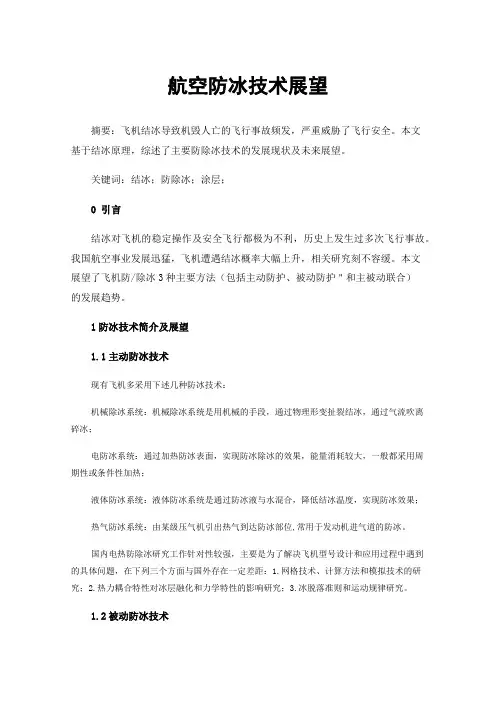
航空防冰技术展望摘要:飞机结冰导致机毁人亡的飞行事故频发,严重威胁了飞行安全。
本文基于结冰原理,综述了主要防除冰技术的发展现状及未来展望。
关键词:结冰;防除冰;涂层;0 引言结冰对飞机的稳定操作及安全飞行都极为不利,历史上发生过多次飞行事故。
我国航空事业发展迅猛,飞机遭遇结冰概率大幅上升,相关研究刻不容缓。
本文展望了飞机防/除冰3种主要方法(包括主动防护、被动防护"和主被动联合)的发展趋势。
1防冰技术简介及展望1.1主动防冰技术现有飞机多采用下述几种防冰技术:机械除冰系统:机械除冰系统是用机械的手段,通过物理形变扯裂结冰,通过气流吹离碎冰;电防冰系统:通过加热防冰表面,实现防冰除冰的效果,能量消耗较大,一般都采用周期性或条件性加热;液体防冰系统:液体防冰系统是通过防冰液与水混合,降低结冰温度,实现防冰效果;热气防冰系统:由某级压气机引出热气到达防冰部位,常用于发动机进气道的防冰。
国内电热防除冰研究工作针对性较强,主要是为了解决飞机型号设计和应用过程中遇到的具体问题,在下列三个方面与国外存在一定差距:1.网格技术、计算方法和模拟技术的研究;2.热力耦合特性对冰层融化和力学特性的影响研究;3.冰脱落准则和运动规律研究。
1.2被动防冰技术1.2.1简介被动防冰是指通过在基体表面构建抗结冰功能涂层,减少冰对基体表面的黏附力和覆冰量的技术。
被动防冰技术成本低、耗能少、易于实施,是一种理想的防冰方法。
研究表明,基体表面结冰与其和水分子的相互作用力有关,作用力越大,冰的黏附强度就越高。
改变涂层表面的化学组成,降低涂层的表面能,提高疏水性可减少表面冰的黏附力。
1.2.2复合材料防冰涂料自20世纪30年代以来,包括美国航空航天局(NASA)在内的一些研究单位开始了长达半个多世纪对飞行器防冰的研究,随着基础化工材料技术的发展,各种新型低表面能疏水涂层材料引起了人们的注意[1],见表1。
表1国外相关产品基本情况公司涂料产品性能指标防冰性能检测Microph axeCoating s公司1)Phasebreak TMESL2)Phasebreak TM2X3)Phasebreak TMSH溶剂型有机硅改性环氧1)温度-2.2℃,风速67 m / s ,涂层与风夹角为0,结冰后,涂层与风速呈15°进行脱冰;2)温度-9.4℃,风速67m/s.涂层与风呈15°,结冰后旋转到0°,然后再回到15°看脱冰情况Ecologicol Coatings公司3000系列1)水性有机硅改性环氧2)疏水、憎冰3)单层Ecologi col Coutings Wearlon F -11)水性有机硅改性环氧2)附着力降低91.5%据AMIL检测到2004年,该涂料是当时防冰效果最好的防冰涂料Nusil Silicone Technology公司美国联合工艺公司R21801)溶剂型有机硅树脂2)厚度254 pm3)附着力降低97.6%4)透明或半透明5)冰剪切强度(19~50)kPa1)-10C冻结8h,应力松弛40h,然后再测附着力:2)正在提高接触角2011年南京大学的杨淑清[2]等以铝合金板为基材,在其表面制备6种不同的含氟涂层,研究不同涂层的防冰效果差异。
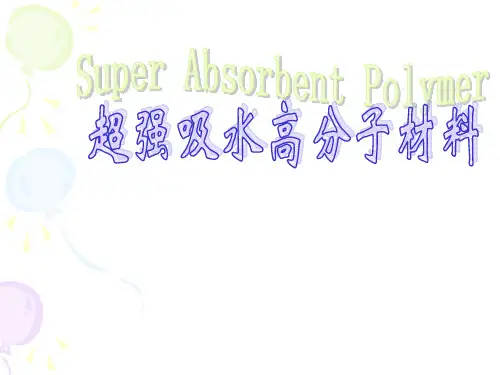
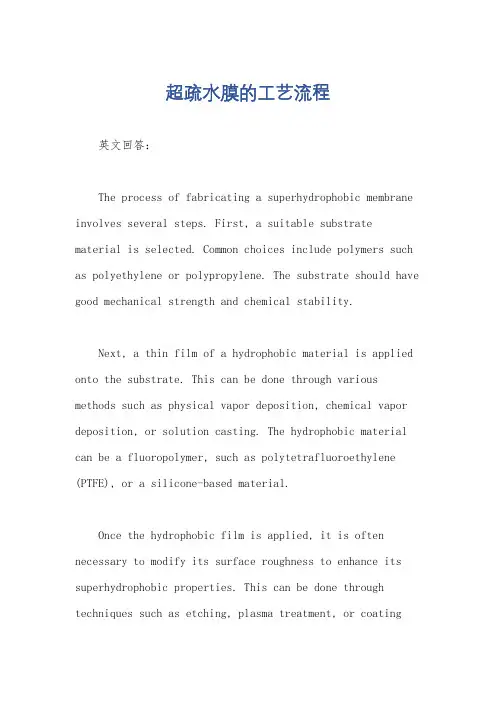
超疏水膜的工艺流程英文回答:The process of fabricating a superhydrophobic membrane involves several steps. First, a suitable substrate material is selected. Common choices include polymers such as polyethylene or polypropylene. The substrate should have good mechanical strength and chemical stability.Next, a thin film of a hydrophobic material is applied onto the substrate. This can be done through various methods such as physical vapor deposition, chemical vapor deposition, or solution casting. The hydrophobic material can be a fluoropolymer, such as polytetrafluoroethylene (PTFE), or a silicone-based material.Once the hydrophobic film is applied, it is often necessary to modify its surface roughness to enhance its superhydrophobic properties. This can be done through techniques such as etching, plasma treatment, or coatingwith nanoparticles. The roughness of the surface createsair pockets that prevent water from making contact with the membrane surface.After the surface roughness is optimized, the membraneis often subjected to a post-treatment step to further enhance its superhydrophobicity. This can involve the application of a low surface energy coating or a self-assembled monolayer of a hydrophobic compound.Finally, the fabricated membrane is tested for its superhydrophobic properties. This can be done by measuring the contact angle of water droplets on the membrane surface.A contact angle greater than 150 degrees indicates superhydrophobic behavior.中文回答:制备超疏水膜的工艺流程包括几个步骤。
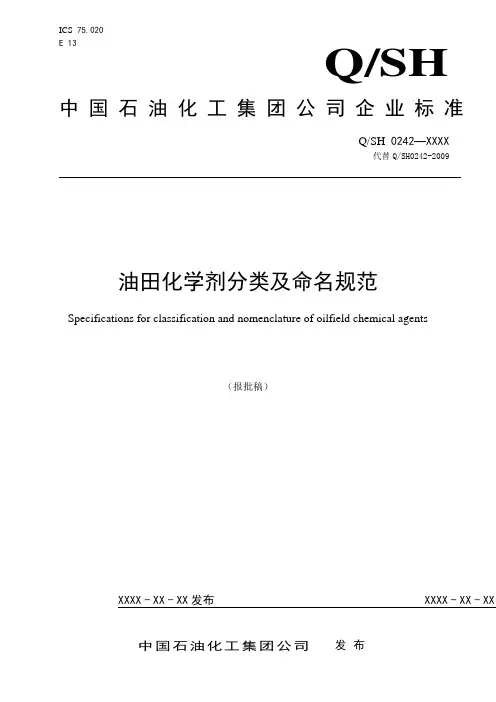
ICS 75.020E 13 Q/SH 中国石油化工集团公司企业标准Q/SH 0242—XXXX代替Q/SH0242-2009油田化学剂分类及命名规范Specifications for classification and nomenclature of oilfield chemical agents(报批稿)XXXX-XX-XX发布XXXX-XX-XX前言本标准代替Q/SH 0242-2009 《油田化学剂分类及命名规范》。
本标准与Q/SH 0242-2009 相比主要技术差异为:——增加了油田化学剂的定义。
——增加了分类原则,增加了分类类型及化学名称的英文名称。
——增加了命名原则,完善了命名方法。
——删除了油田化学剂包装标志部分。
——修改了油田化学剂的分类,“采油用化学剂”中增加了“防砂用化学剂”、“注水用化学剂”、“调剖堵水用化学剂”、“采油用其他化学剂”。
——钻井液处理剂分类中将原标准中的“1 通用化学类化学剂”单独列出。
删除了原标准中的“13 表面活性剂”、“17 高温稳定剂”,“9 页岩抑制剂”修订为“5 抑制剂”,增加了“4 防塌剂”、“14 屏蔽暂堵剂”和“18 其他类”。
——油井水泥外加剂分类中,“5 降滤失剂”修订为“3 降失水剂”、“7 减轻剂”修订为“10 减轻外掺料”、“8 防漏剂”修订为“11 堵漏外掺料”,“9 加重剂”修订为“9 加重外掺料”、增加了“6 增强剂”、“7 膨胀剂”、“12 热稳定剂”、“13 其他类”。
——酸化/酸压用化学剂分类中将原标准中的“1 酸化用防淤渣剂”修订为“15 抗酸渣剂”、“8 酸化用铁稳定剂”修订为“12 铁离子稳定剂”、“9 酸化用缓速剂”修订为“13 化学缓速剂”,增加了“2 交联剂”、“3 降阻剂”、“5 缓蚀增效剂”、“10 转向剂”、“14 互溶剂”和“17 其他类”。
——压裂用化学剂分类中删除了原标准中的“3 压裂用缓蚀剂”和“11 压裂用支撑剂”,“8 压裂用减阻剂”修订为“3 降阻剂”、“14 转向剂”修订为“14 缝高控制剂”,增加了“5 抗高温稳定剂”、“6 防乳化剂”、“10 起泡剂”、“11 泡沫稳定剂”、“12 消泡剂”、“13 暂堵剂”和“16 其他类”。
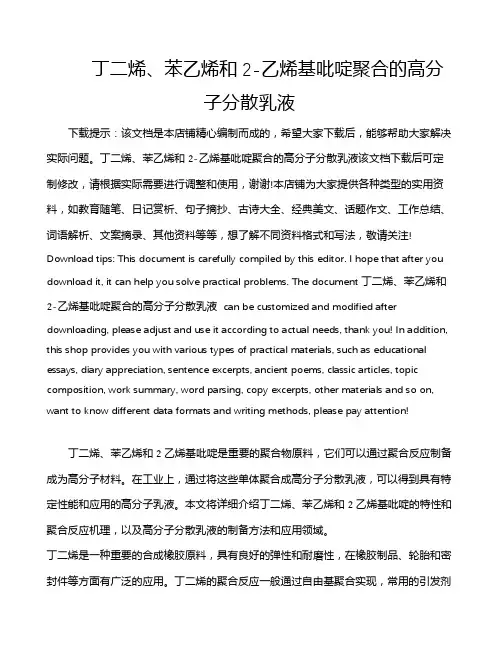
丁二烯、苯乙烯和2-乙烯基吡啶聚合的高分子分散乳液下载提示:该文档是本店铺精心编制而成的,希望大家下载后,能够帮助大家解决实际问题。
丁二烯、苯乙烯和2-乙烯基吡啶聚合的高分子分散乳液该文档下载后可定制修改,请根据实际需要进行调整和使用,谢谢!本店铺为大家提供各种类型的实用资料,如教育随笔、日记赏析、句子摘抄、古诗大全、经典美文、话题作文、工作总结、词语解析、文案摘录、其他资料等等,想了解不同资料格式和写法,敬请关注! Download tips: This document is carefully compiled by this editor. I hope that after you download it, it can help you solve practical problems. The document 丁二烯、苯乙烯和2-乙烯基吡啶聚合的高分子分散乳液 can be customized and modified after downloading, please adjust and use it according to actual needs, thank you! In addition, this shop provides you with various types of practical materials, such as educational essays, diary appreciation, sentence excerpts, ancient poems, classic articles, topic composition, work summary, word parsing, copy excerpts, other materials and so on, want to know different data formats and writing methods, please pay attention!丁二烯、苯乙烯和2乙烯基吡啶是重要的聚合物原料,它们可以通过聚合反应制备成为高分子材料。
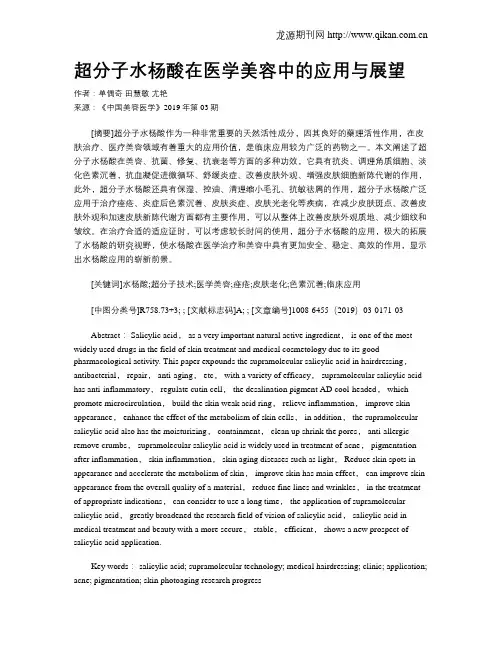
超分子水杨酸在医学美容中的应用与展望作者:单偶奇田慧敏尤艳来源:《中国美容医学》2019年第03期[摘要]超分子水杨酸作为一种非常重要的天然活性成分,因其良好的藥理活性作用,在皮肤治疗、医疗美容领域有着重大的应用价值,是临床应用较为广泛的药物之一。
本文阐述了超分子水杨酸在美容、抗菌、修复、抗衰老等方面的多种功效,它具有抗炎、调理角质细胞、淡化色素沉着,抗血凝促进微循环、舒缓炎症、改善皮肤外观、增强皮肤细胞新陈代谢的作用,此外,超分子水杨酸还具有保湿、控油、清理缩小毛孔、抗敏祛屑的作用,超分子水杨酸广泛应用于治疗痤疮、炎症后色素沉着、皮肤炎症、皮肤光老化等疾病,在减少皮肤斑点、改善皮肤外观和加速皮肤新陈代谢方面都有主要作用,可以从整体上改善皮肤外观质地、减少细纹和皱纹。
在治疗合适的适应证时,可以考虑较长时间的使用,超分子水杨酸的应用,极大的拓展了水杨酸的研究视野,使水杨酸在医学治疗和美容中具有更加安全、稳定、高效的作用,显示出水杨酸应用的崭新前景。
[关键词]水杨酸;超分子技术;医学美容;痤疮;皮肤老化;色素沉着;临床应用[中图分类号]R758.73+3; ; [文献标志码]A; ; [文章编号]1008-6455(2019)03-0171-03Abstract: Salicylic acid, as a very important natural active ingredient, is one of the most widely used drugs in the field of skin treatment and medical cosmetology due to its good pharmacological activity. This paper expounds the supramolecular salicylic acid in hairdressing,antibacterial, repair, anti-aging, etc, with a variety of efficacy, supramolecular salicylic acid has anti-inflammatory, regulate cutin cell, the desalination pigment AD cool-headed, which promote microcirculation, build the skin weak acid ring, relieve inflammation, improve skin appearance, enhance the effect of the metabolism of skin cells, in addition, the supramolecular salicylic acid also has the moisturizing, containment, clean up shrink the pores, anti-allergic remove crumbs, supramolecular salicylic acid is widely used in treatment of acne, pigmentation after inflammation, skin inflammation, skin aging diseases such as light, Reduce skin spots in appearance and accelerate the metabolism of skin, improve skin has main effect, can improve skin appearance from the overall quality of a material, reduce fine lines and wrinkles, in the treatment of appropriate indications, can consider to use a long time, the application of supramolecular salicylic acid, greatly broadened the research field of vision of salicylic acid, salicylic acid in medical treatment and beauty with a more secure, stable, efficient, shows a new prospect of salicylic acid application.Key words: salicylic acid; supramolecular technology; medical hairdressing; clinic; application; acne; pigmentation; skin photoaging research progress水杨酸(Salicylic acid)是一种天然活性成分,也称为β-羟基酸(BHA),作为一种非常重要的天然活性成分,它存在于许多植物,如:柳树皮、甜桦树皮及白珠树中。
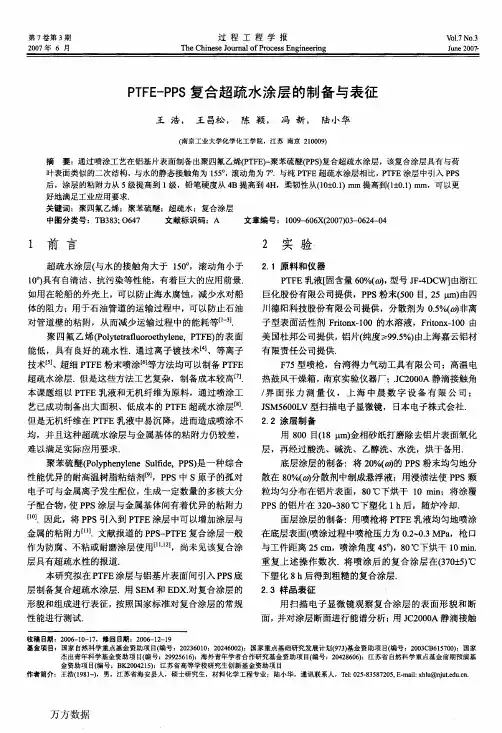
第7卷第3期2007年6月过程工程学报TheCtlineseJo啪alofProcessEnginee抽g、,01.7No_3J吼e200≯PTFE—PPS复合超疏水涂层的制备与表征王浩,王昌松,陈颖,冯新,陆小华(南京工业大学化学化工学院,江苏南京2lo009)摘要:通过喷涂工艺在铝基片表面制备出聚四氟乙烯(PTFE卜聚苯硫醚(PPS)复合超疏水涂层,该复合涂层具有与荷叶表面类似的二次结构,与水的静态接触角为1550,滚动角为70.与纯PTFE超疏水涂层相比,PTFE涂层中引入PPs后,涂层的粘附力从5级提高到1级,铅笔硬度从4B提高到4H,柔韧性从(10±0.1)mm提高到(1±0.1)mm,可以更好地满足工业应用要求.关键词:聚四氟乙烯;聚苯硫醚:超疏水;复合涂层中图分类号:TB383;0647文献标识码:A文章编号:1009—606x(2007)03—0624一041前言2实验超疏水涂层(与水的接触角大于1500,滚动角小于100)具有自清洁、抗污染等性能,有着巨大的应用前景.如用在轮船的外壳上,可以防止海水腐蚀,减少水对船体的阻力;用于石油管道的运输过程中,可以防止石油对管道壁的粘附,从而减少运输过程中的能耗等【1。
3】.聚四氟乙烯(Polyte妇fluoroethylene,PTFE)的表面能低,具有良好的疏水性.通过离子镀技术【41、等离子技术[5】、超细PTFE粉末喷涂【6】等方法均可以制备PTFE超疏水涂层.但是这些方法工艺复杂,制备成本较高[7】.本课题组以PTFE乳液和无机纤维为原料,通过喷涂工艺已成功制备出大面积、低成本的PTFE超疏水涂层【81.但是无机纤维在PTFE乳液中易沉降,进而造成喷涂不均,并且这种超疏水涂层与金属基体的粘附力仍较差,难以满足实际应用要求.聚苯硫醚(P01)rphenyleneSulfide,PPS)是一种综合性能优异的耐高温树脂粘结剂[9】,PPS中S原子的孤对电子可与金属离子发生配位,生成一定数量的多核大分子配合物,使PPS涂层与金属基体间有着优异的粘附力¨01.因此,将PPS引入到PTFE涂层中可以增加涂层与金属的粘附力【11】.文献报道的PPS—PTFE复合涂层一般作为防腐、不粘或耐磨涂层使用【11,121,尚未见该复合涂层具有超疏水性的报道.本研究拟在PTFE涂层与铝基片表面间引入PPS底层制备复合超疏水涂层.用SEM和EDx.对复合涂层的形貌和组成进行表征,按照国家标准对复合涂层的常规性能进行测试.2.1原料和仪器PTFE乳液【固含量60%(曲,型号JF.4Dcw】由浙江巨化股份有限公司提供,PPS粉末(500目,25¨m)由四川德阳科技股份有限公司提供,分散剂为0.5%(动非离子型表面活性剂F矗tollx.100的水溶液,Fritollx.100由美国杜邦公司提供,铝片(纯度≥99.5%)由上海嘉云铝材有限责任公司提供.F75型喷枪,台湾得力气动工具有限公司;高温电热鼓风干燥箱,南京实验仪器厂;.JC2000A静滴接触角/界面张力测量仪,上海中晨数字设备有限公司;JSM5600L、,型扫描电子显微镜,日本电子株式会社.2.2涂层制备用800目(18¨m)金相砂纸打磨除去铝片表面氧化层,再经过酸洗、碱洗、乙醇洗、水洗,烘干备用.底层涂层的制备:将20%(动的PPS粉末均匀地分散在80%(动分散剂中制成悬浮液;用浸渍法使PPS颗粒均匀分布在铝片表面,80℃下烘干10min;将涂覆PPS的铝片在320一380℃下塑化1h后,随炉冷却.面层涂层的制备:用喷枪将PTFE乳液均匀地喷涂在底层表面(喷涂过程中喷枪压力为0.2—0.3MPa,枪口与工件距离25cm,喷涂角度450),80℃下烘干10Tnin.重复上述操作数次.将喷涂后的复合涂层在(370±5)℃下塑化8h后得到粗糙的复合涂层.2.3样品表征用扫描电子显微镜观察复合涂层的表面形貌和断面,并对涂层断面进行能谱分析;用JC2000A静滴接触收稿日期:2006—10—17,修回日期:2006—12—19基金项目:国家自然科学重点基金资助项目(编号:20236010;20246002);国家重点基础研究发展计划(973)基金资助项目(编号:2003CB615700);国家杰出青年科学基金资助项目(编号:29925616);海外青年学者合作研究基金资助项目(编号:20428606);江苏省自然科学重点基金前期预演基金资助项目(编号:BK2004215);江苏省高等学校研究生创新基金资助项目作者简介:王浩(1981_),男,江苏省海安县人,硕士研究生,材料化学工程专业;陆小华,通讯联系人,Tel:025.83587205,E.mail:xhlu@njut.edu舳.第3期王浩等:PTFE_PPS复合超疏水涂层的制各与表征625角/界面张力测量仪测量水滴在涂层表面不同区域的静态接触角,取平均值;涂层常规性能按国标测试(粘附力按照GB/T9286.88标准测试,涂层硬度按照GB6739.86标准测试,涂层柔韧性按照GB/T1731.93标准测试).3结果与讨论3.1复合涂层的底层结构用扫描电子显微镜观察涂层底层(PPS层)的结构,图1涂层底层的SEM图片及水滴在底层的静态接触角F培1SEMimageofPPScoatingandthecontactangleofwateronthesurfhce见图1,可见涂层底层较平整,粗糙结构不明显,这是由于PPS在高温烧结时熔融,具有很好的流动性,从而均匀地分布在基体表面[9].而水滴在PPS涂层上的静态接触角为820,达不到超疏水的要求.3.2复合涂层的表面结构用扫描电子显微镜观察复合涂层的表面结构,并与荷叶表面的微结构比较(实验所选荷叶样品为新鲜荷叶,喷金后观察),结果见图2.图2(a)表明复合涂层表面存在一系列随机分布的乳突结构,这些乳突直径为0.1—100um,是一种微米一亚微米结构.对其中一个乳突[图2(a)中方框]进一步观察发现,这些乳突表面还存在着亚微米的二次结构,见图2(b).自然界中的荷叶表面具有超疏水性.研究发现,荷叶表面由许多随机分布的乳突构成,乳突的平均直径为1一10“m,见图2(c).而单个乳突(方框内)上又存在着平均直径为120—130nm的纳米二次结构,见图2(d).通过对比图2(a)和图2(c),图2(b)和图2(d)发现,制备的复合涂层与荷叶具有极为相似的表面结构,这种微米结构与纳米结构相结合的二次结构正是引起表面超疏水的根本原因[3,7】.复合涂层表面上水滴的静态接触角[见图2(a)】平均值为1550,滚动角为70,说明制备的复合涂层具备了超疏水性.(a)PTFE—PPscoatingsumce锄dcon协ct柚91eofwatermesllr‰e(b)PTFE-PPscoatingsurface(c)LotIls1eaf(d)Lotllsleaf图2PTFE—PPS涂层、荷叶表面SEM图片及水在涂层表面的静态接触角Fig.2SEMimagesofPTFE—PPScoatingsu血ceandlotus1ea£andcontactangleofwateronthePTFE—PPSsurface626过程工程学报第7卷Energy(×102keV)Energy(×102kev)图3复合涂层断面SEM图片及EDx能谱图Fig.3SEMimageandEDXanalysisofcrosssectionofPTFE—PPScoating3.3复合涂层断面能谱分析对复合涂层的断面进行EDx能谱分析,见图3.图3(a)表明复合涂层的断面厚度约为80“m.选取接近铝片处的涂层为18区域,涂层表面处为24区域.分别对两域进行EDx面扫描能谱分析,表明14区域内的硫元素含量较高,同时也含有一定的氟元素,见图3(b);24区域内含有大量的氟元素,无硫元素,见图3(c).这说明在铝片基体表面(复合涂层底层)涂层的主要成分是PPS,而涂层表面成分为PTFE.在图3(a)中复合涂层并无明显的分层现象,说明PPS与PTFE粒子很好地粘结在一起.3.4Casse方程分析粗糙表面的润湿性可用Cassie方程[13]来解释.Cassie方程为cos口亏屉os缺一(1忉,(1)其中曰为液体在粗糙表面的静态接触角,绣为液体在光滑表面的静态接触角,即本征接触角,厂为单位面积被润湿的固体表面积分率,l_厂为单位面积上的空气分率.图2(a)和图3表明制得的复合涂层具有微米与亚微米结构相结合的粗糙表面,且涂层表面物质为PTFE.水在该粗糙表面的静态接触角秒为1550,而光滑PTFE表面的本征接触角德为1080[14】.根据方程(1)计算得到水在该复合涂层表面的空气分率1了达到0.86,说明通过本工艺制得的粗糙表面具有较大的空气分率,从而使涂层实现了超疏水性.3.5复合涂层常规性能表征超疏水涂层在实际应用中还需要具有良好的力学性能,如与基体的粘附力、硬度和弯曲强度等,这样才能保持涂层的超疏水性,满足工业应用的要求.按照国标测试要求,分别对铝基片表面的PTFE涂层、PTFE—PPs复合涂层和文献报道的PTFE—PPS涂层的常规性能进行对比测试,结果见表1表1复合涂层常规性能测试!皇坚型塾旦婴!堕箜竺!12塑里旦!堑!12堂垫壁Tcs“tem1等等蠹丽赋Test㈣odPTFEPTFE—PPSConglutinationpower5~6l1【ll】GB厂r9286_88Iugidit),/pencilrigidity4B4H2H~4H‘121GB6739.86Flexility(n肌)lO土o.11±o.11【11】GB/T1731.93璺!坐竖!!Q!堑!i!!i!竺=表1表明,在PTFE超疏水涂层和铝基片表面引入PPS底层后,复合涂层的粘附力从5级提高到1级,硬度从4B提高到4H,柔韧性从(10±0.1)mm提高到(1±0.1)mm,水在表面的静态接触角仍为1550.文献的PTFE—PPS防腐蚀、不粘复合涂层的粘附力为1级,硬度为2H一4H,柔韧性为1I衄,各项常规指标均与本工作制得的复合超疏水涂层相当,但是水在其表面的静态接触角只有1300,未实现超疏水性.4结论在铝基片表面制备出一种PTFE_PPS超疏水复合涂层,该复合涂层具有与荷叶表面类似的二次结构,与水的静态接触角为1550,滚动角为70.同时,复合涂层具有很好的力学性能,与铝基片的粘附力达到1级,硬度达到4H,柔韧性达到(1±O.1)mm.参考文献:【1]Al【imN,K蛆mitoH,ToshiyaWRccentStudiessuper-hydrophobicFilIIls【J].Monatsh.Chem.,2001,132:3141.[2】coulsonSR,WbodwardI,Bady“JPS.Super-repellentconlpositeF1uor叩01ymersurfaces【J】.J.Phys.Chem.B,2000,104(37):8836—8840.[3]翟锦,李欢军,李英顺,等.碳纳米管列阵超双疏性质的发现【J].物理,2002,31(8):483_486.[4]Ve哪masulleIliS,DrelichJ,MillerJD.Hydrophobici够ofIon_platedPTFECoatings【J】.Prog.0r苫.Coat.,1997,3l:265—270.第3期王浩等:PTFE斗Ps复合超疏水涂层的制各与表征627[5]Jefh.eyPY,ThomasJM.ul廿ahydr叩hobicPolymerSllrfacesPr印aredbySinmltaIleousAblationofP01ypropyleneaIldSputteringofP01“te柏nuoroethylene)UsingRadioFrequencyPlasI士1a[J】.Macromolecules,1999,32(20):6800—6806.【6】YhrIlauchiGMillerJD,Sa“oH.wemngCharacteristicsofNewlyDevelopedwrater_r印ellentMalerial[J】.colloidsSlllf.A,1996,116:125—134.【7】XieQ,XuJ,JiaIlgLFacileCreationofSupe卜引1phiphobicCoatingSllrfacewimBionicMicrost九lctIlrefJ】.A“MateL,2004,16:302—305.【8】陆小华,王昌松,王浩,等.一种由无机超细纤维增强的具有超疏水和疏油表面的含氟涂层的制备方法[P】.中国专利:1786086,2005—11—14.[9】石塞安.工程塑料[M】.上海:上海科技出版社,1999.362.[10】李继红,侯灿淑,余自力,等.聚苯硫醚涂层/金属基体的界面研究[J].高分子材料科学与工程,1998,14(3):94—99.[11]杨生荣,李同生,周兆福,等.PPs—PTFE防粘耐磨涂层的研制及其在食品烤盘上的应用【J].塑料,1999,28(1):38—1.[12]唐守秋,刘丰,张新恩,等.PTFE/PPs防腐不粘复合涂层的研究[J】.山东科学,1999,12(1):31—36.[13】SllIlTL,FengL,GaoXF'eta1.BioinspiredSurfaceswimSpecialWettabili哆【J】.Acc.Chem.Res.,2004,38(8):644—652.【14】CoulsonSR,wbodwardI,BadyalJPS.Supe卜r印e11entCompositeFluoropolymerSurfaces[J].J.Phys.Chem.B,2000,104:8836—8840.PreparationandCharacterizationofSuperhydrophobicPTFE—PPSCompositeCoatingWANGHao,WANGCh肋g-son吕CHENYing,FENGXin,LU)(iao-hua@ollege可Chem妇蜘硼dChemic翻Eng衲eenn昏Nanj衲gu疵盯si妙可Technolo影,Nd哟ing.Ji锄gstl2io009.Chtn由Abstract:Thesuperhydrophobicpolytetranuoroenlylene-polyphenylenesulfide(PTFE—PPS)compositecoatillgwaspr印aredbysprayingcoatingonthea1啪inumsubs柏te.Scall王lingelec仃0n埘cmscopy(SEM)investigationindicatedthatmeconlpositecoatinghadmesimilargI】rfacesmlcturetomatoflotusleaf.Thewatercon诅ctangleonmecoatingsurfacewas1550andtIleslidin2a芏lglewas70.ComparedwiththepllresupemydrophobicPTFEcoatingonmealumin啪subs仃a慨mecon91佣nationforceofthecompositecoatingwasimprovedf.romgrade5to鳓de1,thepencilrigidi田wasincreased行om4Bto4H,a士ld也enexilityofthecompositecoatingwasimprovedf-rom(10±0.1)mmto(1±0.1)rnm.Thecompositccoatingwassu伍cienttotllerequircmentsofindustrialapDlication.Keywords:p01ytetmnuomethylene;polyphenylenesulfide;superhy出ophobic;conlpositecoatingPTFE-PPS复合超疏水涂层的制备与表征作者:王浩, 王昌松, 陈颖, 冯新, 陆小华, WANG Hao, WANG Chang-song, CHEN Ying,FENG Xin, LU Xiao-hua作者单位:南京工业大学化学化工学院,江苏,南京,210009刊名:过程工程学报英文刊名:THE CHINESE JOURNAL OF PROCESS ENGINEERING年,卷(期):2007,7(3)被引用次数:1次1.Aldra N;Kazuhito H;Toshiya W Recent Studies on Super-hydrophobic Films[外文期刊] 2001(1)2.Coulson S R;Woodward I;Badyal J P S Super-repellent Composite Fluoropolymer Surfaces[外文期刊] 2000(37)3.翟锦;李欢军;李英顺碳纳米管列阵超双疏性质的发现[期刊论文]-物理 2002(08)4.Veerarnasuneni S;Drelich J;Miller J D Hydrophobicity of Ion-plated PTFE Coatings[外文期刊] 1997(3)5.Jeffrey P Y;Thomas J M Ultrahydrophobic Polymer Surfaces Prepared by Simultaneous Ablaion of Polypropylene and Sputtering of Poly(tetrafluoroethylene) Using Radio Frequency Plasma[外文期刊] 1999(20)6.Yamauchi G;Miller J D;Saito H Wetting Characteristics of Newly Developed Water-repellent Material [外文期刊] 19967.Xie Q;Xu J;Jiang L Facile Creation of a Super-amphiphobic Coating Surface with Bionic Microstructure[外文期刊] 2004(4)8.陆小华;王昌松;王浩一种由无机超细纤维增强的具有超疏水和疏油表面的含氟涂层的制备方法 20059.石塞安工程塑料 199910.李继红;侯灿淑;余自力聚苯硫醚涂层/金属基体的界面研究[期刊论文]-高分子材料科学与工程 1998(03)11.杨生荣;李同生;周兆福PPS-PTFE防粘耐磨涂层的研制及其在食品烤盘上的应用[期刊论文]-塑料 1999(01)12.唐守秋;刘丰;张新恩PTFE/PPS防腐不粘复合涂层的研究 1999(01)13.Sun T L;Feng L;Gao X F Bioinspired Surfaces with Special Wettability[外文期刊] 2004(08)14.Coulson S R;Woodward I;Badyal J P S Super-repellent Composite Fluoropolymer Surfaces[外文期刊] 2000(37)1.张燕.王贤明.ZHANG Yan.WANG Xian-ming超疏水表面制备技术的研究进展[期刊论文]-现代涂料与涂装2009,12(2)2.谭俊.万家瑰.张志伟.庞维涛.TAN Jun.WAN Jia-gui.ZHANG Zhi-wei.PANG Wei-tao超疏水涂层的制备及其性能[期刊论文]-全面腐蚀控制2011,25(4)3.华军利.文秀芳.郑大锋.皮丕辉.程江.杨卓如.HUA Jun-li.WEN Xiu-fang.ZHENG Da-feng.PI Pi-hui.CHENG Jiang.YANG Zhuo-ru有机-无机杂化超疏水涂层的制备[期刊论文]-电镀与涂饰2009,28(12)4.张靓.赵宁.张晓艳.谭帅霞.卢晓英.徐坚超疏水涂层的结构设计和应用[会议论文]-2008本文链接:/Periodical_hgyj200703038.aspx。
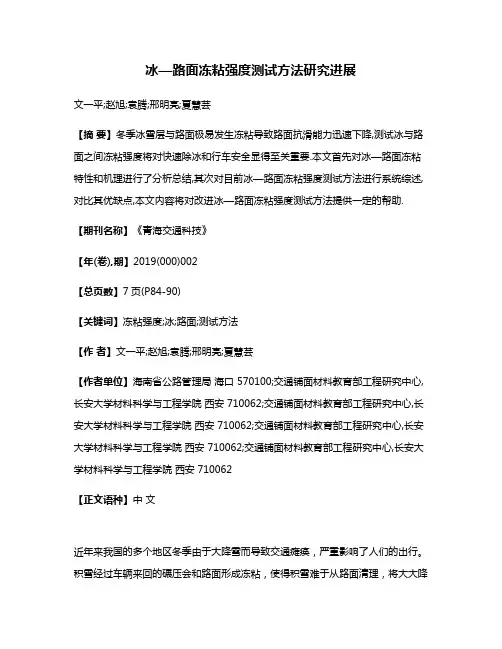
冰—路面冻粘强度测试方法研究进展文一平;赵旭;袁腾;邢明亮;夏慧芸【摘要】冬季冰雪层与路面极易发生冻粘导致路面抗滑能力迅速下降,测试冰与路面之间冻粘强度将对快速除冰和行车安全显得至关重要.本文首先对冰—路面冻粘特性和机理进行了分析总结,其次对目前冰—路面冻粘强度测试方法进行系统综述,对比其优缺点,本文内容将对改进冰—路面冻粘强度测试方法提供一定的帮助.【期刊名称】《青海交通科技》【年(卷),期】2019(000)002【总页数】7页(P84-90)【关键词】冻粘强度;冰;路面;测试方法【作者】文一平;赵旭;袁腾;邢明亮;夏慧芸【作者单位】海南省公路管理局海口 570100;交通铺面材料教育部工程研究中心,长安大学材料科学与工程学院西安 710062;交通铺面材料教育部工程研究中心,长安大学材料科学与工程学院西安 710062;交通铺面材料教育部工程研究中心,长安大学材料科学与工程学院西安 710062;交通铺面材料教育部工程研究中心,长安大学材料科学与工程学院西安 710062【正文语种】中文近年来我国的多个地区冬季由于大降雪而导致交通瘫痪,严重影响了人们的出行。
积雪经过车辆来回的碾压会和路面形成冻粘,使得积雪难于从路面清理,将大大降低路面的抗滑性能,对行车安全造成威胁,当不能清理的积雪经过冷暖交融,会造成路面、桥面结冰,严重影响行车安全和人民的生命财产安全,造成巨大的经济损失[1]。
对于冻粘界面问题,国内的研究集中于对航天飞行器、飞机机翼或机身表面与冰层的冻粘界面问题,输电线路、电塔上的冻粘界面问题以及船舶或水利设施表面与冰层的冻粘界面问题上[2]。
随着人们对交通安全问题的日益关注,冰层与路面的冻粘界面问题逐渐被重视起来,冰层与沥青路面的冻粘界面强度测试方法研究也被相继报导。
本文首先对冰—路面冻粘特性和机理进行详细论述,其次根据加载方式不同对冰—路面冻粘强度测试方法进行了分类,并对比分析了各种方法的优缺点。
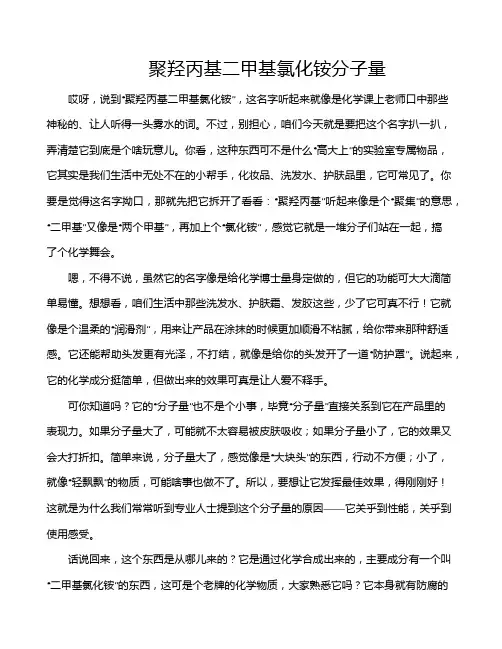
聚羟丙基二甲基氯化铵分子量哎呀,说到“聚羟丙基二甲基氯化铵”,这名字听起来就像是化学课上老师口中那些神秘的、让人听得一头雾水的词。
不过,别担心,咱们今天就是要把这个名字扒一扒,弄清楚它到底是个啥玩意儿。
你看,这种东西可不是什么“高大上”的实验室专属物品,它其实是我们生活中无处不在的小帮手,化妆品、洗发水、护肤品里,它可常见了。
你要是觉得这名字拗口,那就先把它拆开了看看:“聚羟丙基”听起来像是个“聚集”的意思,“二甲基”又像是“两个甲基”,再加上个“氯化铵”,感觉它就是一堆分子们站在一起,搞了个化学舞会。
嗯,不得不说,虽然它的名字像是给化学博士量身定做的,但它的功能可大大滴简单易懂。
想想看,咱们生活中那些洗发水、护肤霜、发胶这些,少了它可真不行!它就像是个温柔的“润滑剂”,用来让产品在涂抹的时候更加顺滑不粘腻,给你带来那种舒适感。
它还能帮助头发更有光泽,不打结,就像是给你的头发开了一道“防护罩”。
说起来,它的化学成分挺简单,但做出来的效果可真是让人爱不释手。
可你知道吗?它的“分子量”也不是个小事,毕竟“分子量”直接关系到它在产品里的表现力。
如果分子量大了,可能就不太容易被皮肤吸收;如果分子量小了,它的效果又会大打折扣。
简单来说,分子量大了,感觉像是“大块头”的东西,行动不方便;小了,就像“轻飘飘”的物质,可能啥事也做不了。
所以,要想让它发挥最佳效果,得刚刚好!这就是为什么我们常常听到专业人士提到这个分子量的原因——它关乎到性能,关乎到使用感受。
话说回来,这个东西是从哪儿来的?它是通过化学合成出来的,主要成分有一个叫“二甲基氯化铵”的东西,这可是个老牌的化学物质,大家熟悉它吗?它本身就有防腐的作用,能防止一些霉菌、细菌什么的。
所以,聚羟丙基二甲基氯化铵不仅仅是为了让你使用的东西更加顺滑,还得保证这些产品的“健康”状态,算是“守护神”之一啦。
不过,别看它这么厉害,大家用到它的机会其实挺多的,但你估计也没怎么注意过。

Superhydrophobic fluoropolymer-modified copper surface via surface graft polymerisation for corrosion protectionShaojun Yuan a ,⇑,S.O.Pehkonen b ,Bin Liang a ,Y.P.Ting c ,K.G.Neoh c ,E.T.Kang caCollege of Chemical Engineering,Sichuan University,Chengdu 610065,ChinabChemical Engineering Program,Masdar Institute of Science and Technology,PO Box 54224,Abu Dhabi,United Arab Emirates cDepartment of Chemical and Biomolecular Engineering,National University of Singapore,Kent Ridge,Singapore 119260,Singaporea r t i c l e i n f o Article history:Received 18December 2010Accepted 2May 2011Available online 11May 2011Keywords:A.Copper A.Polymer B.XPSC.Polymer Coatings C.Superhydrophobicitya b s t r a c tWith the objective of developing materials with repellent surfaces by combining both low surface energy and rough structure,superhydrophobic fluoropolymer films were prepared via surface graft polymerisa-tion from copper substrates.A vinyl-terminated trimethoxysilane was firstly immobilised on the etched-copper surface to introduce active carbon–carbon double bonds.Subsequent graft polymerisation of 2,2,3,4,4,4-hexafluorobutyl acrylate (HFBA),in the presence of a polymerisation initiator 4,40-azobis-(4-cyanpentanoic acid),yielded the fluoropolymer films on the copper substrates.The resultant P(HFBA)-grafted surfaces not only exhibited desired superhydrophobic property with water contact angle above 150°,but substantially improved the corrosion resistance of copper substrates.Ó2011Elsevier Ltd.All rights reserved.1.IntroductionCopper is a metal with a wide range of applications owing to its high electrical and thermal conductivity,mechanical workability,and malleability.However,it is an active metal that does not resist well to corrosion,particularly in the presence of aggressive chlo-ride anions [1].Various strategies have been developed to address the growing need for the inhibition of copper anic inhibitors containing polar groups [2],heterocyclic compounds (including N,S,O)with polar functional groups [3],and conjugated double bonds [4],have been extensively reported to protect copper from corrosion,due to their chelating action and the formation of an insoluble diffusion barrier on the substrate surfaces [5,6].The major disadvantage in using organic inhibitors is their inherent toxicity,which poses potential risks to environments and human health.Alternatively,self-assembled monolayers (SAMs)formed by reactions of alkyltrialkoxysilanes and alkanethios with copper substrates have recently been proposed corrosion inhibition [7–10].SAMs suffer from the drawback that the layers have limited stability and molecule-sized defects allow electrolytes to reach the underlying substrates [11].Another widely-used approach to inhibit corrosion is electropolymerisation of conducting polymer coatings,such as polypyrrole and polyaniline,on metal substrate surfaces [12,13].The major concerns of electrodeposited conduct-ing polymer coatings are water permeability and weak adhesion [13].The breakdown of weak bonds at the metal/polymer interface will result in structural or functional failures and ultimately leads to irreversible corrosion damage at the interface [14].It is therefore highly desirable to develop a novel,and yet general,approach for combating copper corrosion.Recently,considerable effort has been devoted to using super-hydrophobic films as corrosion inhibitors [15–20].Superhydropho-bic surfaces with a water contact angle above 150°display many remarkable physicochemical properties,such as water repellency,self-cleaning,lubricity and antifouling properties [21].The superhydrophobic films inhibit corrosion of metal substrates by providing an effective barrier to the penetrating electrolytes.It is well-known that the wettability of a solid surface is governed by both the surface chemical composition and geometrical micro-structure [22–24].Superhydrophobicity of a surface can thus be achieved by enhancing the surface roughness and lowering the surface energy [25].Different approaches have been reported for the fabrication of superhydrophobic surfaces.These approaches in-clude chemical vapour deposition [26],sol–gel processing [27],electrodeposition [28,29],solution immersion [24,30],electrospin-ning [31],layer-by-layer assembly [32],plasma polymerisation [33],and graft polymerisation [34].Among these approaches,graft polymerisation is a particularly good method due to its high effi-ciency in creating high density polymer brushes,better structural control of the resulting coatings,and good stability and durability of the substrate surfaces arising from robust covalent bonds.How-ever,relatively few studies on the fabrication of superhydrophobic surfaces via surface graft polymerisation have been documented0010-938X/$-see front matter Ó2011Elsevier Ltd.All rights reserved.doi:10.1016/j.corsci.2011.05.008Corresponding author.Tel./fax:+862885460557.E-mail address:yuanshaojun@ (S.Yuan).[34–36].Functional polymer coatings grafted from reactive groups on metal substrate surfaces have been shown to provide good cor-rosion resistance to metal substrates[37,38].Moreover,a thin poly(2,2,2-trifluoroethyl acrylate)film deposited on aluminium surfaces by admicellar polymerisation was reported to endow the substrate surface with a highly hydrophobic property,and to act as effective barrier coatings to keep away aggressive ions from reaching the metal substrates,thus inhibiting the occurrence of crevice corrosion[39].Herein,superhydrophobicfluoropolymerfilms were fabricated on copper substrates via surface-initiated free radical graft poly-merisation.The process of surface functionalisation is shown sche-matically in Fig.1.A vinyl-terminated trimethoxylsilane was coupled to the etched copper surface via self-assembly.Subse-quently,fluoropolymerfilms were synthesised on the copper sur-face by surface-graft polymerisation of2,2,3,4,4,4-hexafluorobutyl acrylate(HFBA)to produce superhydrophobic surfaces.The success in each functionalisation step was ascertained by X-ray photoelec-tron spectroscopy(XPS),scanning electron microscopy(SEM),and water contact angle measurements.The anticorrosion behaviour of the superhydrophobicfluoropolymerfilms in a3.5wt.%aqueous NaCl solution was evaluated by Tafel polarisation curves and elec-trochemical impedance spectroscopy(EIS).The stability of the superhydrophobic surfaces as a function of immersion time was also investigated.For the comparison purpose,bare copper coupons were used as controls under the same experimental conditions. 2.Material and methods2.1.Materials and chemicalsThe CDA110copper coupon(nominal composition:Cu P99.9%) was obtained from Metal Samples Company(Munford,AL,USA). 2,2,3,4,4,4-Hexafluorobutyl acrylate(HFBA)used for the graft poly-merisation was obtained from Sigma–Aldrich Chemical Co.(St. Louis,A)and was used as received.Solvents,such as N,N0-dimethylformide(DMF,99.8%)and toluene(99.8%)were dried with sodium.The polymerisation initiator,4,40-azobis(4-cyanenta-noic acid)(ACP),and the vinyl-terminated trimethoxylsilane cou-pling agent,3-(trimethoxysilyl)propyl methacrylate(TMSPMA, >98%),were obtained from Fluka Chem.Co.(Milwaukee,WI),and were used as received.Nitric acid(65%),hydrogen peroxide (37%),acetone,methanol,ethanol,sodium chloride and other chemicals were of reagent grade and were used as received.2.2.Copper surface preparation and introduction ofactive vinyl groups on copper surface by silanisation processingThe copper coupons were ground sequentially using a series of grit(180,500,800and1200)SiC paper to give a smooth surface. Disc coupons with a diameter of15mm and a thickness of3mm were used for surface characterisation and electrochemical studies. The newly polished coupons were washed with deionised water, acetone,ethanol,and deionised water,in that order,for5min each to degrease and clean the surface,and then were etched by immer-sion in a HNO3(65%)and H2O2(30%)mixed solution(v/v,1:1)for 2min at room temperature,using procedures described in detail previously[40].After etching,the substrates were immediately rinsed ultrasonically with deionised water and washed with copi-ous amounts of deionised water,followed by drying with a stream of purified N2and then stored in a vacuum desiccator.The vinyl-terminated trimethoxylsilane coupling agent,TMSPMA,was intro-duced onto the etched copper substrates via self-assembly.As illustrated in Fig.1,the etched copper coupons were immersed in10mL of1%ethanol solution of TMSPMA for6h at room temper-ature to produce the self-assembled silane monolayers(the Cu–TMSPMA surfaces).The TMSPMA-coupled surfaces were then washed with copious amounts of methanol and deionised water, respectively,and dried in an oven at80°C for60min.2.3.Graft polymerisation of HFBA from the vinyl-containing copper surfacesFor the synthesis of P(HFBA)films from the Cu–TMSPMA sur-faces,1.75mL(1.0mmol)of HFBA was introduced into5mL of DMF in a PyrexÒtube.The reaction mixture was degassed by bub-bling Argon for30min.The Cu–TMSPMA coupon was introduced into the degassed monomer solution with the addition of 0.02mmol(11.21mg)of ACP.The reaction mixture was kept in a 75°C oil bath for2and6h,to give rise to the Cu-g-P(HFBA)1 and Cu-g-P(HFBA)2surfaces,respectively.After the reaction,the resulting surfaces were washed thoroughly with copious amounts of ethanol to remove the residual monomers and adsorbed homopolymers.2.4.Surface characterisationThe surface composition of the functionalised coupons was determined by X-ray photoelectron spectroscopy(XPS).The XPS measurements were performed with a Kratos AXIS HSi XPS spectrometer(Kratos Analytical Ltd.,UK)with an Al K a X-ray source(1486.6eV photons),using procedures described pre-viously[41].All binding energies(BEs)were referred to the C1s peak(284.6eV)arising from surface hydrocarbons(or adventi-tious hydrocarbon).The contact angles(CA)measurements were performed on a VCA optima surface analysis system(AST Prod-ucts Inc.,Billerica,MA,USA)using the sessile drop method with a3l L deionised water droplet.After dropping a water droplet onto the sample surface,contact angles were automatically determined by the analysis system.The average CA value was obtained from measurements atfive or more different locations on the same samples.The accuracy of CA value was±2°.Scan-ning electron microscope(SEM)images were obtained on a JEOL JSM-5600(Tokyo,Japan)SEM to reveal the morphology of sub-strate surfaces.The thickness of the grafted polymerfilms on the copper substrates was determined by ellipsometry.The mea-surements were carried out on a variable angle spectroscopic ellipsometer(model VASE,J.A.Woollam,Inc.,Lincoln,NE)at incident angles of70°and75°in the wavelength range250–1000nm.The refractive index of the driedfilms at all wave-lengths was assumed to be1.5in the Cauchyfilm modelused S.Yuan et al./Corrosion Science53(2011)2738–27472739for the simulation offilm thickness.All measurements were con-ducted in dry air at room temperature.For each sample,thick-ness measurements were made on at least three different surface locations.Data were recorded and processed using the WVASE32software package.2.5.Electrochemical characterisationIn all cases,the corrosion experiments were carried out in a 3.5wt.%aqueous NaCl solution under aerated conditions.The anti-corrosion behaviour of the superhydrophobicfilms on the copper surface was investigated by the measurements of Tafel polarisation curves and EIS spectra on an Autolab PGSTAT30electrochemical workstation(Ecochemie Co.,The Netherlands).A conventional three-electrode glass corrosion cell with a capacity of500mL was used.The copper coupons were mounted on a PVDF holder, leaving a circular area of0.785cm2in contact with the solution, to serve as the working electrode.An Ag/AgCl electrode was used as the reference electrode,and a platinum rod as the counter elec-trode.Tafel polarisation curves were obtained at a scan rate of 2mV/s in the range of±250mV vs.the open circuit potential (OCP).The impedance spectra were recorded under OCP using a 10mV amplitude sinusoidal signal in the frequency range of 0.005–100,000Hz.2.6.Stability and durability of the superhydrophobicfluoropolymer filmsThe changes in superhydrophobicity of thefluoropolymer-grafted surface as a function of exposure time were investigated by measuring the CA value after a predetermined immersion time in a3.5wt.%aqueous NaCl solution.SEM images of the coupon sur-face were also captured after21days of exposure in a3.5wt.% aqueous NaCl solution to evaluate the stability of the superhydro-phobic P(HFBA)films.3.Results and discussionTo achieve a superhydrophobic surface,surface roughness has the amplification effect on the hydrophobic properties[24,40].In the present study,a nitric acid and hydrogen peroxide oxidising mixture(v/v,1:1)was used as the etching reagent to generate the rough surface,with the simultaneously removal of carbon con-taminants from the substrate surface.The etched copper surface was characterised by X-ray photoelectron spectroscopy(XPS). The presence of hydroxyl groups on the etched copper surface was ascertained by XPS analysis(Supporting Information, Fig.S1).A vinyl-terminated trimethoxysilane coupling agent was immobilised on the etched substrate surfaces via self-assembly to provide the active functional groups for the subsequent surface functionalisation.3.1.Silanisation of copper surfaces and surface-graft polymerisation of HFBACoupling of the copper surface with3-(trimethoxysilyl)propyl methacrylate(TMSPMA)results in the formation of silane mono-layers containing active carbon–carbon double bonds.The thick-ness of the silane monolayer is about1.7±0.4nm.Parts a and b of Fig.2shows the respective wide scan,C1s and Si2p core-level spectra of the Cu–TMSPMA surface.In comparison with the wide scan spectrum of the etched copper surface(Supporting Informa-tion,Fig.S1a),in addition to the C1s and O1s spectral lines with substantially enhanced intensities,two photoelectron lines at binding energies(BEs)of about99and151eV,attributable to Si 2p and Si2s species[42],respectively,are also observed in the wide scan spectrum of the Cu–TMSPMA surface(Fig.2a),indicative of the successful immobilisation of TMSPMA on the copper surface. The[Si]:[C]ratio,as determined from the Si2p and C1s core-level spectral area ratio,is approximately0.13,which is close to the the-oretical value of0.142for TMSPMA.The curve-fitted C1s core-le-vel spectrum consists of four peak components with BEs at283.9, 284.6,286.2and288.4eV,attributable to the C A Si,C A H,C A O and O@C A O species[42],respectively(Fig.2b).The area ratio of the C A Si,C A H,C A O and O@C A O peak components of the Cu–TMSPMA surface(about1.0:3.9:1.1:0.8)is comparable to the theoretical va-lue of1:4:1:1for the molecular structure of TMSPMA.The single Si 2p peak component at the BE of about102.5eV is associated with Si A O species[42](inset of Fig.2b),indicating that the TMSPMA monolayer is immobilised on the copper surface via the robust Si A O bonds.Graft polymerisation of2,2,3,4,4,4-hexafluorobutyl acrylate was conducted by surface-initiated free radical polymerisation. The resulting surfaces from2and6h of polymerisation reaction are referred to respectively as the Cu-g-P(HFBA)1and Cu-g-P(HFBA)2surfaces.Parts c and d in Fig.2shows the respective wide scan,C1s and F1s core-level spectra for the Cu-g-P(HFBA)1surface.The appearance of two additional photoelec-tron lines,F1s(at a BE of685eV)and F KL23L23(at a BE of 832eV),as well as the decrease in intensity of Si and Cu signals, is discernible in the wide scan spectrum of the Cu-g-P(HFBA)1 surface(Fig.2c),indicative of successful grafting of P(HFBA) brushes from the Cu–TMSPMA surface.The presence of sur-face-grafted HFBA polymer can also be deduced from the appearance of C1s peak components with BEs at about285.6, 289.4,291.4and293.8eV,attributable to C A CF x,CF A CF x,C A F2 and C A F3species[20,42],respectively(Fig.2d),as well as the appearance of the F1s core-level signal at the BE of about 689eV[42](inset of Fig.2d).Thesefluorine peak components are characteristics of the P(HFBA)brushes.On the other hand, the persistence of Si and Cu signals in the wide scan spectrum indicates that the thickness of the P(HFBA)brushes is less than the probing depth of the XPS technique(about8nm in an organ-ic matrix[42])after2h of reaction.The thickness of the P(HFBA)films grafted on the copper substrate is about7±2nm after2h of polymerisation.This point is further confirmed by the devia-tion of the peak area ratios of C A O,O@C A O,CF A CF x,C A F2and C A F3(about 2.1:1.7:2.1:1.0:1.1)from the theoretical value of 1:1:2:1:1.The increase in the relative amount of the C A O and O@C A O species probably has resulted from the contribution of the underlying TMSPMA monolayer,as well as from(at least in part)the adsorption of adventitious carbon and hydrocarbons during sample handling.Upon prolonging the reaction time to6h,the wide scan spec-trum of the Cu-g-P(HFBA)2surface shows only four photoelectron lines at the BEs of about285,530,685and832eV,associated with the C1s,O1s,F1s and F KL23L23species,respectively(Fig.2e).The disappearance of the Si and Cu signals on the Cu-g-P(HFBA)2sur-face indicates that the thickness of the P(HFBA)brushes is larger than the probing depth of the XPS technique after6h of reaction. The thickness of the P(HFBA)films grafted on the copper substrate is approximately19±3nm after6h of polymerisation.The[F]/[C] ratio,as determined from the sensitivity factor corrected F1s and C 1s core-level spectral area ratio,is approximately0.83,which is close to the theoretical[F]/[C]ratio of0.86for the HFBA unit of the P(HFBA)polymers.The curve-fitted C1s core-level spectrum of the Cu-g-P(HFBA)2surface consists of seven peak components with BEs at284.6eV for the C A H species,at 285.6eV for the C A CF x species,at286.2eV for the C A O species, at288.0eV for the O@C A O species,at289.4eV for the CF A CF x spe-cies,at291.4eV for the C A CF2species,and at293.8eV for the2740S.Yuan et al./Corrosion Science53(2011)2738–2747C A CF3species[42].The area ratio of these peak components (about3.4:2.1:1.1:1.2:1.9:1.0:1.0)is consistent with the chemical structure of P(HFBA)(theoretical component ratio of 3:2:1:1:2:1:1).Thus,the P(HFBA)films have been successfully immobilised on the copper surface.3.2.Surface wettability and morphologyThe surface wettability and surface microstructure of various substrates were characterised respectively by water contact angle measurements and SEM.After etched in the nitric acid and hydro-gen peroxide oxidising mixtures,the copper substrate has a rough surface with nubble-protrusion and island structures(Fig.3a and b),and is hydrophilic with a water contact angle of about61°(Fig.3a0).The photo image of water setting on the etched copper surface is shown in Fig.3a00.The hydrophilic property exists over the entire copper surface.After coupling of the TMSPMA mono-layer,the copper surface becomes relatively smooth and hydro-phobic with a water contact angle of about119°without island structures(Supporting Information,Fig.S2a,S2a0and2b).The sub-stantial increase in hydrophobicity further confirms the successful immobilisation of TMSPMA on the copper surface.Parts c and d of Fig.3shows the representative SEM images at different magnifications and water contact angle images of the Cu-g-P(HFBA)1surface.In comparison with those of the etched and silanised copper surfaces,the roughness of the substrate surface changes dramatically after grafting of the P(HFBA)brushes.The SEM image in Fig.3c shows a micro-porous P(HFBA)film covering the entire substrate surface.The high-resolution SEM image (Fig.3d)reveals the foliage-like structure of P(HFBA)film.The foli-age-like microstructures of the P(HFBA)film are essential for superhydrophobicity.It is well-known thatfluorine is the most effective element for lowering the surface free energy because it has a small atomic radius and the highest electronegativity among all atoms.It forms a stable covalent bond with carbon,resulting in a surface with low surface energy[43].However,even aflat surface with the lowest surface free energy,that of the closest hexagonal packed A CF3groups,shows a water contact angle of only119°[44].The combination of low surface free energy and surface roughness,arising from the foliage-like microstructures in Cu-g-P(HFBA)1,gives rise to a superhydrophobic surface with a water contact angle of around154°(Fig.3c0).The optical images of water droplets at different locations of the Cu-g-P(HFBA)1substrate sug-gest uniform surface superhydrophobicity.Upon increasing the reaction time to6h,the high-resolution SEM image(Fig.3f)shows the randomly packed nanoslices or petal-likefluoropolymer structures on the Cu-g-P(HFBA)2surfaces,leading to the further increase in the water contact angle to about159°(Fig.3e0).Thus, the superhydrophobicity of thefluoropolymer-grafted substrate surface wasascertained.S.Yuan et al./Corrosion Science53(2011)2738–274727413.3.Determination of the anticorrosion behaviour of the surface-functionalised copper couponsThe anticorrosion performance of superhydrophobic fluoropoly-mer films was determined by the measurements of Tafel polarisa-tion curves and electrochemical impedance spectra (EIS).Fig.4shows the Tafel polarisation curves of bare and surface-functional-ised coupons after 1day and 21days of exposure in a 3.5wt.%NaCl solution.The values of corrosion current densities (i corr ),corrosion potentials (E corr ,vs.Ag/AgCl),and Tafel slopes (b a and b c )were ob-tained by extrapolating the linear portions of the anodic and catho-dic branches to their intersection using procedures described previously [41].Parameters associated with Tafel polarisationcurves are summarised in Table 1.Inhibition efficiency (g )is calcu-lated by Eq.(1)below [41],g ¼i o Ài corri oÂ100%ð1Þwhere i o and i corr correspond to current densities of the bare copper and the surface-functionalised coupons,respectively.As shown in Table 1,the slight shift in the corrosion potential,E corr (vs.Ag/AgCl),to positive direction and the decrease in corrosion current density,i corr ,with exposure time are observed on the bare copper coupons,attributable to the formation of protective oxide films (consisting mainly of Cu 2O)on the substrate surfaces.As compared to the bare copper,the Cu–TMSPMA coupons display more noble values oftheSEM images at low (1000Â)and high (5000Â)magnifications of the (a and b)the etched Cu,(c and d)Cu-g -P(HFBA)1and (e 0)are contact angle profiles of water droplet on the etched Cu,Cu-g -P(HFBA)1and Cu-g -P(HFBA)2surfaces,respectively.optical images of water droplets at different locations on the etched Cu,Cu-g -P(HFBA)1and Cu-g -P(HFBA)2surfaces,corrosion potential and smaller i corr values throughout the exposure periods(Table1),indicative of the protective nature of the self-assembled silane monolayers[45].However,the i corr value of the Cu–TMSPMA coupon increases approximately by50%relative to the initial value after21days of exposure,indicating that the pro-tective capability of the silane monolayer is compromised by the prolonged attack of aggressive ClÀanions.As for the superhydrophobicfluoropolymer-coated copper cou-pons,the corrosion potential,E corr(vs.Ag/AgCl),undergoes a posi-tive shift to more noble values as compared to those of the bare copper and the Cu–TMSPMA coupons,and remain relatively con-stant throughout the exposure periods(Table1),attributable to the presence of protective superhydrophobicfluoropolymerfilms on the substrate surface.The ennoblement in corrosion potential is a common phenomenon for the polymer-coated coupons with respect to the bare metal coupon[46].The magnitude of i corr for the Cu-g-P(HFBA)1and Cu-g-P(HFBA)2coupons is lower by about 8-and12-fold,respectively,as compared to that of the bare copper coupon after21days of exposure in a3.5wt.%aqueous NaCl solu-tion,indicating that the superhydrophobicfluoropolymerfilms render the desired protection capability against corrosion.The g values of the Cu-g-P(HFBA)2coupons,calculated from Eq.(1),re-main higher than90%throughout the exposure periods,and are al-ways larger than those of the Cu-g-P(HFBA)1coupons(Table1), suggesting that the anticorrosion property is associated with wet-tability,thickness and the structure of the grafted-fluoropolymer films.The protective capability of the superhydrophobicfluoro-polymerfilms probably originates from both the water repelling property and the physical diffusion barriers of thefluoropolymer coatings.The barrier behaviour of the coatings has been known to be dependant mainly on their thickness and structures,as well as the chemical properties of inhibitor molecules[47].EIS can provide important information on the reaction mecha-nisms and kinetics of an electrochemical system under investigation [46].Fig.5shows the EIS data of the bare copper and surface-func-tionalised copper coupons after1day and21days of exposure in a 3.5wt.%aqueous NaCl solution.These EIS data are analysed by using the Boukamp’s EQUIVCRT program with an appropriate equivalent electrical circuit(EEC).Insets of Fig.5d(i.e.,Fig.5d0and d00)shows two EECs proposed to model the respective EIS data of the bare cop-per and the surface-functionalised copper coupons.EEC(d0)is used to model a single charge transfer reaction on the bare metal sub-strate,while ECC(d00)has been widely used to estimate the barrier, protection and degradation properties of polymer coatings[46].In ECC(d00),the pore resistance(R po)represents the extent of ionic con-duction through a polymer in an electrolytic environment,and is commonly used as a criterion for assessing the extent of corrosion protection derived from the organic coatings,while the constant phase element(CPE)of coating,Q c,is used to substitute coating capacitance,C c,by taking into account of the phenomenarelatedTable1Analysis results of Tafel polarisation curves of the bare copper and the surface-functionalised copper coupons after immersion in a3.5wt.%aqueous NaCl solution for1day and 21days.Time(days)Specimen b c e(mV/dec)b a f(mV/dec)E corr.g(V,vs.Ag/AgCl)i corr.(l A cmÀ2)m h(mm yÀ1)g i(%) 1Bare Cu aÀ19588À0.1934.00.40–Cu–TMSPMA bÀ231259À0.1210.50.1269.1Cu-g-P(HFBA)1cÀ2562720.04 2.250.0393.4Cu-g-P(HFBA)2dÀ2592890.08 1.610.0295.321Bare CuÀ217194À0.1622.20.26–Cu–TMSPMAÀ244259À0.1315.90.1928.6Cu-g-P(HFBA)1À2462770.01 2.790.0487.5Cu-g-P(HFBA)2À2552740.08 1.930.0291.3a Bare Cu refers to a newly polished copper coupon.b Cu–TMSPMA refers to the etched Cu coupon with immobilised TMSPMA via self-assembly reaction.c,d Reaction conditions:1mmol of HFBA in a5mL of DMF solution with0.02mmol of AIBN as initiator at65°C for2and6h,respectively.e bcrefers to the Tafel slope of the cathodic polarisation curve.f barefers to the Tafel slope of the anodic polarisation curve.g Ecorrrefers to the potential where the current reaches zero under polarisation.h m denotes corrosion rate.i g denotes inhibition efficiency of the grafted polymeric coatings,calculated from equation g¼ði corrÀi origÞ=i origÂ100%.S.Yuan et al./Corrosion Science53(2011)2738–27472743to the heterogeneous surface and diffusion process[46].Thefitted EIS parameters are shown in Table2.The diameters of the Nyquist loop of thefluoropolymer-grafted coupons are significantly larger than those of the bare copper and Cu–TMSPMA coupons,indicative of the enhancement of polarisa-tion resistance by the superhydrophobicfluoropolymerfilms (Fig.5a and c).The magnitude of total impedance plot of theflu-oropolymer-grafted coupon is larger by more than one order of magnitude than that of the bare copper coupon(Fig.5b and d). For the bare copper coupon,the charge transfer resistance,R ct, increases gradually from0.85to1.6k X cm2after21days of expo-sure in a3.5wt.%aqueous NaCl solution(Table2),indicating that the corrosion rate of copper decreases owing to the formation of protective oxidefilms in an aerated solution.The R ct value of the Cu–TMSPMA coupon undergoes a gradual decrease with exposure time,and becomes slightly larger than that of the bare copper cou-pons after21days of exposure,indicative of the gradual loss of passivity of the self-assembled silane monolayer.This result is in good agreement with the previousfindings that the durability and the corrosion resistance of SAMs are limited under harsh aque-ous environments[47].In the case offluoropolymer-grafted coupons,the R ct values are significantly larger than those of the bare copper and the Cu–TMSPMA coupons(Table2),indicative of the substantial decrease in the corrosion rate of the copper substrates under the protection of superhydrophobicfluoropolymerfilms.Generally,thecorrosionTable2Fitted parameters of EIS spectra of the bare copper and the surface-functionalised copper coupons after immersion in a3.5wt.%aqueous NaCl solution for1day and21days.Time(days)ParametersSpecimen R s c(X cm2)R f/R po d(k X cm2)Q f/Q c e R ct f(k X cm2)Q dl g g h(%)Y oÂ10À3(XÀ1cmÀ2s n)n0Y1Â10À3(XÀ1cmÀ2s n)n11Bare Cu a12.9–––0.850.610.78–Cu–TMSPMA b19.00.550.200.69 3.440.180.8075.2Cu-g-P(HFBA)1b21.4 4.520.160.4711.80.210.6792.8Cu-g-P(HFBA)2b24.6 5.310.060.5012.90.190.6193.4 21Bare Cu13.60.210.260.85 1.62 1.030.48–Cu–TMSPMA24.60.320.410.64 2.280.510.8128.8Cu-g-P(HFBA)118.3 3.310.170.5310.80.1484.9Cu-g-P(HFBA)225.1 4.640.110.5111.80.130.6686.2a The EIS spectrum of the bare Cu coupons after1day of immersion in a3.5wt.%NaCl solution isfitted with the equivalent circuit(d0)of Fig.4.b The EIS spectra of the bare Cu coupons after21days of immersion and the surface-functionalised coupons arefitted with the equivalent circuit(d00)of Fig.4.c Rsresistance of the electrolyte solution.d Rpothe pore resistance of the grafted polymeric coatings and R f resistance of the surface oxidefilm.e Qcconstant phase element(CPE)of the grafted polymeric coatings and Q f CPE of the surface oxidefilm.f Rctcharge transfer resistance of the electrical double layer(EDL).g QdlCPE of EDL.h g refers to inhibition efficiency of the grafted polymeric coatings,calculated from equation g¼ðR ctÀR oct Þ=R ctÂ100%.2744S.Yuan et al./Corrosion Science53(2011)2738–2747。